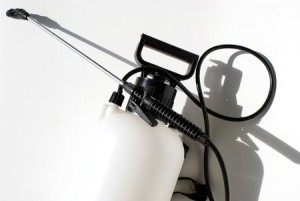 Herbicides can be one of the quickest and most effective ways to control weeds. However many chemicals are toxic and they come with a few risks that we need to manage.
Herbicides can be one of the quickest and most effective ways to control weeds. However many chemicals are toxic and they come with a few risks that we need to manage.
So what issues do we need to be aware of? And what should we be doing to protect ourselves and our staff from potential hazards?
Here’s a quick checklist that you can use to help manage your herbicide risks:
1. Understand what you’re dealing with
- Have you been appropriately trained to handle and apply chemicals?
- Do you know how to identify the appropriate herbicide for your application (with the lowest toxicity and shortest persistence to meet your needs)?
- Do you understand the manufacturer’s instructions?
- Do you understand what the chemical does and how it works?
- Do you know when best to apply the chemical?
2. Ensure your herbicide storage facilities are appropriate
- Do you maintain records of herbicides you buy and store?
- Do you only buy what you require (avoiding the need for long term storage of large quantities of herbicides)?
- Do you monitor the batch numbers, manufacture dates and expiry dates of each herbicide to ensure your weed control activities are as effective as possible?
- Are you following the manufacturer’s instructions for storage?
- Are all herbicides stored in their original containers and are their labels intact?
- Are your herbicides locked away and well-ventilated at all times (both in storage and transit)?
- Do you store animal feeds, seeds and fertilisers separately from other chemicals?
- Are the different types of chemicals separated to prevent reactions?
- Are chemicals and protective equipment stored in different areas to avoid cross-contamination?
- Do you store face masks and filters separately to other contaminated protective equipment when not in use (for example, in a zip-lock bag or a sealed container)?
- Do you protect chemicals from potential ignition sources?
- Is there adequate warning signage around your chemical storage facilities?
- Are liquid chemicals stored away from solid chemicals (not directly above)?
- Are potential spills contained by bunding?
- Do you have spill cleanup equipment within easy reach (such as absorbent materials and PPE)?
- Do you regularly audit your storage facilities and procedures (at least annually)?
3. Be prepared for safe herbicide use
- Can you readily access the manufacturer’s instructions for use, as well as the applicable Safety Data Sheet (SDS), where you store and use herbicides?
- Do you wear protective equipment to minimise the risk of chemical exposure (such as chemical-resistant gloves, face shields or masks, overalls and goggles)?
- Do you have an emergency response plan?
- Do you have an emergency shower, eyewash and first aid kit where your herbicides are stored and used?
- Do you use chemical decanting kits to reduce the risk of spills and splashes while mixing chemicals?
- Do you only mix the quantity of chemical required for the task at hand?
- Are non-target animals and plants protected from chemicals?
- Have withholding periods and re-entry periods been considered?
- Is equipment triple rinsed after chemical application?
- Are leftover chemicals and rinse water disposed of appropriately (ideally on the treatment site)?
- Do you maintain records of all herbicide application activities?
So how’d you fair with the checklist? Is there anything else you can do to ensure you’re handling herbicides responsibly?